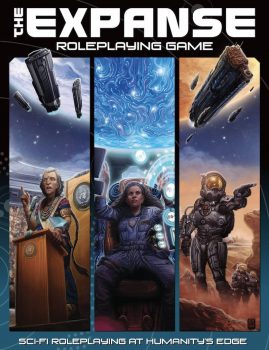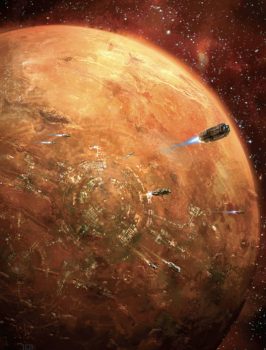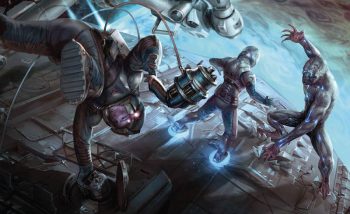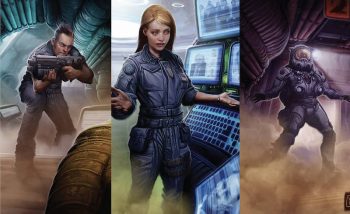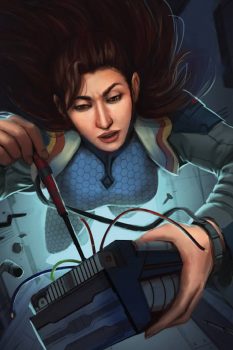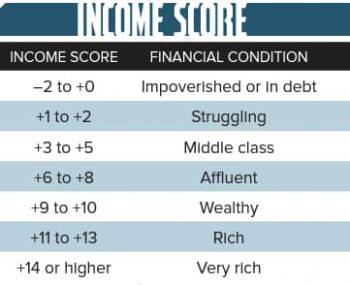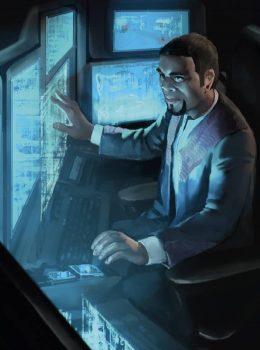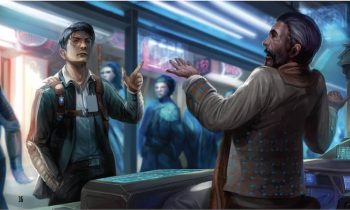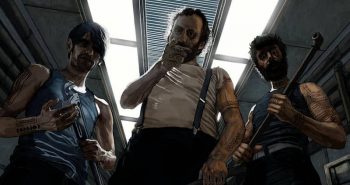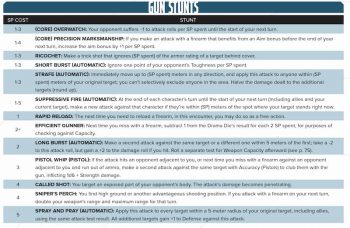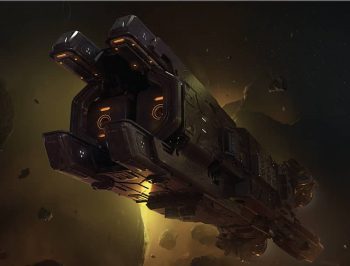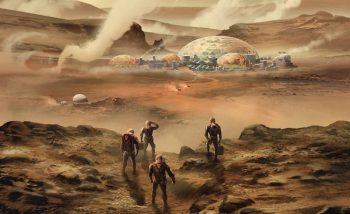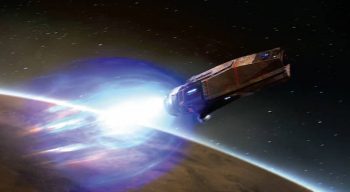Roleplaying in the World of The Expanse
I have heard it said that a number of the central ideas in James S. A. Corey’s The Expanse series were first developed for a tabletop RPG campaign (a series of adventures that usually tell a coherent story arc). I have been unable to validate this, but one find any number of chats positing the game they were playing. And the Foreword for The Expanse RPG does say “for a long run, it was a roleplaying game campaign.” Which RPG, I have not heard definitively stated.
James S. A. Corey is the pen name of authors Ty Franck and Daniel Abraham. What we do know for certain is that they originally pitched The Expanse for an MMPORG (I’m assuming something akin to World of Warcraft). Failing that, they hoped to make a tabletop RPG, and then decided to write the novels, the first of which was Leviathan Wakes in 2011. The ninth and final novel of the series, Leviathan Falls, releases in November this year. The series has exploded in popularity, spawning eight stories and novellas (the last of which is will appear in March 2022), a TV series (entering the sixth and final season in December on Amazon Prime), a board game, comics, and — yes — its own tabletop RPG. Full circle in a way.
The Expanse takes place in a hard science fiction setting and while having the verve and scale of space opera. By the 24th century, humanity has colonized the solar system. Millions live on the Moon, Mars, Ceres, Ganymede, and other moons, asteroids, and rocks. Of course, humans being what they are, conflict exists between the Inners and the Outers, or Belters. Earth and the Moon, united under the United Nations, and Mars are the big guns, dominating politics and generally doing what they want.
The Outers and Belters, those living on asteroids and moons of the gas giants, mine the incredibly valuable minerals the Inners use but see little of the profits. The Outer Planets Alliance (OPA) — a loose alliance of interests and factions — have sought to bring fairness to the Outers via different methods. Meanwhile, the United Nations and Mars — its government is the Martian Congressional Republic, or MCR — have a bitter history themselves. While Mars has a smaller population and armed forces, it typically has superior technology and training in these areas.
The novels and TV series build upon these high level groups, layering in competing interests and subgroups to an already rich tapestry of characters, motivations, and actions — both large and small scale.
The novels take this setting and inject the Protomolecule. Found on Phoebe (a moon orbiting Saturn) by a Martian exploratory team, they inevitably call in a corporation, Protogen, to assist. Turns out, Phoebe is not from our solar system. Saturn’s gravity captured the moon before it could reach its final destination, which no one knows.
What is the protomolecule?
An adaptable set of encodings able to replicate and manipulate matter at a molecular level. Set free, Protogen believed these would have used early life on Earth as raw materials, rebuilding and replacing it with whatever was desired by its creators. Though the origins of the planetoid and the final goals of those who sent it were a mystery, Protogen recognized the power of the tool they had discovered and gave it a name: the protomolecule.
Eventually, Protogen established a lab on Eros, an asteroid in the belt. Things don’t go well, of course. Eros “activates” and starts maneuvering toward Earth. Eventually, the course changes and crashes into Venus. And something weird is going on there now. This is when The Expanse RPG is set.
The game, published by Green Ronin and helmed by veteran designer Steve Kenson, leverages the AGE System, which Green Ronin uses to power its Dragon Age, Fantasy AGE and Modern AGE games. This is my first experience with the AGE System. The game’s base mechanic is role three six-sided dice (3d6), add an ability modifier, and add plus two if the character has a focus. If the roll is above a target number set by the gamemaster (GM), success. If under, the failure.
One of those dice should be a different color, the Drama die, which has a number of different uses in the game: breaking ties, determining the degree of success or failure (1 just barely succeeded, 6 succeeded as well as could be done), and generating Stunt Points (which are used to do cool things). However, you only generate Stunt Points if the two of the three dice rolled match. For example, if you roll 2, 3, 4, no Stunt Points are generated. However, if you roll 2, 2, 5 (and the 5 in this case is the Drama die), then the player generates 5 Stunt Points. Note, in that example, one of the 2s could have been the Drama die, generating only 2 Stunt Points. We’ll come back to Stunt Points.
Characters in The Expanse RPG have nine abilities: Accuracy, Constitution, Fighting, Communication, Dexterity, Intelligence, Perception, Strength, and Willpower. These are assigned a score from -2 to 4. This number is added or subtracted to any die rolls to determine success or failure at an action.
Focuses are specific to the abilities, and the game has a number of them. These include things like Pistols for Accuracy, Persuasion for Communication, Piloting for Dexterity, and so on. (In some other game systems, these function as the equivalent of skills.) How does a character get focuses? Background and profession. The game includes a lightweight lifepath system for generating the character. The player can choose from the options or roll randomly. The first decision or roll is determining if the character is a Belter, Earther, or Martian. The Expanse is a hard science fiction setting, and the only “artificial gravity” that exists is that generated by acceleration or spin. Thus, Belters have, over time adapted in some ways to life in low-gravity environments and need a regimen of drugs to ensure their bone density is good and removing the effects of cosmic radiation. Belters on Earth don’t fare well (in fact, it is a form of torture used on OPA terrorists). Martians can handle Earth gravity, but it’s a challenge. Meanwhile, Earthers are not nearly as adept at negotiating low gravity as Belters.
Characters then roll for social class (this is adjusted for whether they are Belter, Martian, or Earther), and then background — which is based on social class. For example, Lower Class (much more likely for a Belter than an Earther) has the backgrounds Military, Laborer, or Urban. Each of these classes and backgrounds has specific effects on the character. They improve an ability, provide two focuses to choose one of, and provide two talents to choose one of. Additionally, the player can roll 2D6 (that’s two, six-sided dice) or choose from a table that provides improved abilities and more focuses.
Talents provide the player additional benefits associated with an innate proficiency, specialization, or lucky circumstance. Each talent has three degrees of aptitude: Novice, Expert, and Master. Also, some Talents have baseline requirements that must be met. For example, the Hacking talent requires the character to have the Security and Technology focuses. The Novice level grants the player a bit of bonus information on successful Security or Technology rolls. The Master level gives a +2 to the Drama die on Security and Technology rolls. The game includes 40 talents ranging from Improvisation to Dual Weapon Style to Tactical Awareness.
The player then chooses which profession they are in (or they can roll to randomly select the profession). The 30 professions give the player two more focuses and talents to choose one each of. From profession, the player chooses a Drive — the reason why the character does what they do. These are partially intended has story hooks for the GM, but it also provides some benefits. From there, the player determines their character’s income and equipment.
The Expanse RPG does not track money (for example, the player does not keep track of the number of gold pieces or credits or dollars they have). Instead, purchasing things is done via an Income check, and players have an Income score much like an ability — from -2 to +14. The character’s class determines the starting Income score.
Items have a cost. A small drone costs 14 while a base-level pistol costs 10. If a character’s Income score is 4 or higher above the item’s cost (so 18 for the small drone), then they can get it (assuming it is available). Otherwise, the player rolls 3D6 plus their Income score and must beat the item’s cost. The game has rules for overextending your purchasing power, pooling resources, and improving your overall Income score.
At the end of character creation, the player determines their character’s Fortune, Defense, Speed, and Toughness numbers. Defense, the result of 10 plus the Dexterity score, represents how difficult the character is to hit — it is the base dice result an opponent needs to hit you with a shot or punch. This number can be modified by circumstances. Toughness measures the character’s ability to take damage. Any damage during combat first goes against Toughness, which include any armor, and then against Fortune —i f the players wish.
Fortune starts at 15 for starting characters, though the player can increase that through their choice of Drive. Fortune is primarily used for mitigating any damage that gets through Toughness. When it hits 0, your character is taken out. That said, characters can use some Fortune in a Last Ditch Effort after a failed roll (or several) on Advanced Tests.
I am a big fan of Advanced Tests (and their equivalents in other systems). Basically, the notion is that a task — usually a big one — requires a lot of time and planning. Instead of a singular roll to determine success or not, a number of rolls can be made using a variety of applicable Focuses. The GM tallies up the number of successful rolls, and that determines whether the players succeed. For example, hacking a computer system might require 10 total successful rolls. If the players have struggled with the final Cryptography roll, they could spend Fortune to help. In that case, for every Fortune point spent, they lower the difficulty of the roll by 1 point. (Note, for failed rolls in Advanced Tests, some level consequence results, and the book gives several examples.)
How do character’s improve? The Expanse RPG is a level-based system. Unlike Dungeons & Dragons or Starfinder, the opponents do not have experience points earned by defeating them. The GM decides when the players have advanced to the next level (this is a bit like the story-based level up option in Dungeons & Dragons). When characters level up, they increase their Fortune and Toughness along with the options for improving abilities, focuses, and talents. At levels 4, 6, 8, 10, 12, 14, and 16, the players can also gain or improve Specializations. The function a lot like talents, but they are generally broader in their description. For example, one of the Specializations is Agent, and at the Novice level:
You built your life on lies. If you fail a Communication (Deception) test, you can re-roll it, but must keep the result of the second roll.
I spent a lot of time covering character creation, not only because it is a core aspect of many RPGs, but also because it is important to the feel of this RPG, I think. The players can tailor many aspects of their character, finding the right combination of background, class, profession, focuses, and talents that get them just right. It does so in a way that is more streamlined than something like Starfinder (which has expansive character options, but you feel like you have to re-read the manual every time to determine just which improvement you’re going to make) or Mutants & Masterminds (which allows you to create whatever powers you want, but can sometimes seem overwhelming in the options).
The Expanse RPG emphasizes the role of characters in the drama, treating social, exploration, and investigation scenes nearly the same as combat or action scenes. This is also apparent in how damage is treated. Once a character’s Fortune drops to zero, they are Taken Out, to use the terminology of the game. The attacker then determines the condition the target gets. Most likely, they get the Unconscious or Injured condition. An additional hit that causes damage (and with still zero Fortune), then moves from Injured to Wounded. And then from Wounded to Dying. And the Dying condition causes the player to lose 1 Constitution point per round. When it reaches -3, the character is dead.
Additionally, a player can choose to Roll Over, which a player can do prior to being Taken Out. This leaves the choice of the condition up to the player instead of the attacker. The Expanse RPG is not a lethal game like, say, Degenesis: Rebirth or Cyberpunk RED. And certainly not like ALIEN: The Roleplaying Game. This feels right for the setting. The use of Fortune matches, I think, what we see in the books and TV series of the main characters overcoming long odds. It does not always work out that way, but most of the time it does.
Combat is straightforward. A character in their round can take a major and a minor action. Major actions include charging, melee attack, range attack, and running. Minor actions include aiming, moving, preparing, and readying an action.
What The Expanse RPG adds to combat — indeed to many types of activities — are Stunts. Recall that when you roll the dice, if two of the three dice are the same result, you the value of the Drama die determines the number of Stunt Points generated (which Talents can affect in specific circumstances). Each stunt has a point cost (and some are variable meaning you can pour extra Stunt Points into them). Stunt Points cannot be carried over from turn to turn. They must be spent, which, of course, encourages their usage.
The core rules provides general, chase, grappling, infiltration, investigation, attitude, command, and other stunts. These add flavor to the game, particularly if the players help to narrate the stunt at the table.
This is The Expanse, where spaceship travel across the solar system is routine. The chapter on space travel includes a excellent bit explaining the basics of space travel for hard sci-fi enthusiasts. I believe this is the only RPG I can recall that dives into apoapsis and periapsis. Travel times between locations in the solar system are provided on handy tables. These are average distances and will suffice for most games. The travel time is handled in Interlude scenes, where ship maintenance or personal maintenance can be conducted.
Ship combat is, for the most part pretty routine as RPGs go. It is broken into distinct phases for Command, Maneuvers, Electronic Warfare, Weapon Attacks, Defensive Actions, Attack Damage, and Damage Control. The book provides the statistics for a number of ships, from a shuttle to a battleship.
Pages 139 to 180 provide loads of fluff and detail for The Expanse setting. It covers the major factions, providing short histories and current standings. These pages provide wonderful setting background for those new to the setting or those that are familiar with it through the books or TV series. It includes a small glossary of Belter Creole and sign language for those looking to add flavor to the game.
The rest of the book covers basic GM advice, a number of stock NPCs, called Adversaries.
While players have Fortune, the GM has The Churn. This optional tool can be used to spice up the adventure. At the start of each adventure, The Churn pool starts at zero. As the players spend Fortune to alter a die roll, spend four or more Stunt Points, and other items, The Churn pool cranks higher. When it reaches 10, the players face a minor setback. Something becomes more difficult. An NPC becomes more negative to them. When it reaches 20, the players face a major setback. Opposing forces become aware of the players’ investigation and move to get them off the trail. At 30, the players face an epic setback. The investigation is now a trap or an NPC becomes hostile and works against the players.
I found two areas of the book a bit problematic. The first was the generic weapons, which I found problematic for a science fiction setting. Pistol and rifle. That’s it. However, after a couple of read through, I began to understand that these are really the baseline weapons that player and the GM modify by adding Weapon Qualities such as Armor Piercing, Long Range, etc. Nonetheless, I wish a few examples had been provided.
Finally — and I think this was probably due to space limitations — we find none of the interesting drugs here. In particular, I’m thinking of the scene in Leviathan Wakes, which is also in the TV series:
Lopez reached into his pocket, took out a small packet of white lozenges, and popped one into his mouth… Lopez’s pupils contracted to tiny points as he sucked the lozenge. Focus drugs.
While mention is made of drugs, including the infamous Juice used to protect the human body from high-g, I suspect a number of interesting drugs to enhance capabilities (and their consequent downsides) are smuggled and used throughout the system.
That said, both of these are quibbles, and while guns and drugs are used in the book and TV series, they are not prominent features, and the decisions made in The Expanse RPG can be justified. Consider this more of a wish from a long time science fiction RPG GM and scouring pages of equipment looking for just the right thing.
Overall The Expanse RPG is a solid game that does a good job at capturing the flavor and feel of the setting. For those looking to play in this universe, you’ll find much to love in this book.
You can get it at your local gaming store or from Green Ronin directly.
Patrick Kanouse encountered Traveller and Star Frontiers in the early 1980s, which he then subjected his brother to many games of. Outside of RPGs, he is a fiction writer, avid tabletop roleplaying game master, and new convert to war gaming. His last post for Black Gate was Join the Corps! The Colonial Marines Operations Manual for ALIEN: The Roleplaying Game. You can follow him and his brother at Two Brothers Gaming as they play any number of RPGs. Twitter: @twobrothersgam8. Facebook: Two Brothers Gaming.
